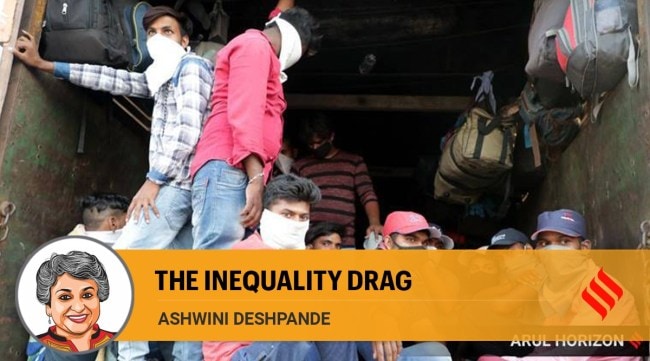Opinion The budget has ignored distress caused by the pandemic
Ashwini Deshpande writes: To get back on the growth track and to increase the size of the economy, it needed to focus on expanding the incomes and consumption of those at the bottom of the pyramid
 Migrant labourers return home amid the Covid pandemic, in Pune. (Express Photo: Arul Horizon, File)
Migrant labourers return home amid the Covid pandemic, in Pune. (Express Photo: Arul Horizon, File) What were the keywords in the 2022 budget speech? Digital, green, climate, Aatmanirbhar, Make in India, capital expenditure, ease of doing business, tax revenues, GST collection. The finance minister emphasised robust tax collections, an optimistic projection for GDP growth and a futuristic economy driven by technology, clean fuel, and smart cities. Which words were either completely missing or sparsely used? Unemployment, poverty, food security, informal sector, migrants, daily wagers, health for all, welfare, social protection, women, youth.
Are the missing words irrelevant or inconsequential? The Covid-19 pandemic is not over. The economy has been badly battered and is in urgent need of a broad-based recovery, not the K-shaped one, where the economic conditions of those at the top of the income/wealth pyramid have improved but the lives and livelihoods of those at the bottom have become more precarious and vulnerable due to high unemployment and inadequate safety nets. The substantial gains that India had made in terms of poverty reduction are under threat of reversal. The share of the top 10 per cent in the total national income stands at 57.1 per cent whereas the share of the bottom 50 per cent in total national income stands at 13.1 per cent. India’s rising inequality is a real and serious problem, likely to jeopardise future growth.
The big-ticket announcement in the budget is an increase in capital expenditure by 35.4 per cent. Note that this would raise the share of this expenditure in GDP from 2.2 per cent last year to 2.9 per cent this year. First, as a fraction of GDP this is not massive, and the increase this year is roughly the same as last year. (Did we see a big jump in employment as a result of increased capex last year?) Two, capex comprises expenditure on creating or upgrading fixed assets, as well as loan repayment. Indeed, an additional Rs 51,971 crore have been allocated towards settlement of outstanding guaranteed liabilities of Air India and this amount has been accounted for in the total expenditure.
Three, while infrastructure investment benefits economic activity, it would be a fallacy to assume that the immediate impact of infrastructure projects would be to expand employment. For one thing, infrastructure projects could be capital- instead of labour-intensive. Secondly, the multiplier effects could be small and not immediate. India has witnessed jobless growth in the past. Finally, not all the capex is for infrastructure. It is concentrated in mainly eight ministries/departments — atomic energy (1.9 per cent of capex); telecommunications (7.2 per cent), defence (20.3 per cent), transfer to states (1.4 per cent), housing and urban affairs (3.6 per cent), railways (18.3 per cent) and road transportation and highways (25 per cent).
MGNREGA is the employer of last resort for the poorest households. Despite the massive unemployment challenge, the budget did not announce an increase in allocation to this crucial safety net programme, which remained at Rs 73,000 crore, same as the budgetary estimate for last year and lower than the revised estimate of Rs 98,000 crore for last year.
While we are still reeling under the biggest health crisis of the century, the expenditure under health continues to be low and misleading as items such as water, sanitation, nutrition, and air pollution (no doubt important determinants of public health) are now clubbed with conventional health expenditure. This makes it harder to track specific expenditure on strengthening health infrastructure and healthcare services. Provision of basic public goods must be a key area of focus. Last year, only 44 per cent of the amount allocated to the Department of Water and Sanitation had been spent till December 2021.
Opportunities for women to participate in paid economic activities have been low and falling in recent years. The omission of this critical divide from the budget speech was disheartening, compounded by the fact that key flagship schemes like Saksham Anganwadi and Poshan 2.0 did not see an increase in budgetary allocation, with the funds earmarked failing to meet the pre-pandemic levels.
On education, the finance minister focused on the marvels of digital education (while the allocation under Digital India e-learning component was reduced to Rs 421 crore from Rs 645 crore in 2021-22), with no mention of how the deep digital divide has resulted in virtually no formal schooling for millions of children with no access to the internet or digital devices. The solution is to immediately open schools, and to improve the quality of schooling instruction. A hundred television channels can never be a substitute for good quality classroom experience.
The two sectors which provide livelihood for millions of Indians, and which overlap to some extent but not completely, are the MSME and the informal sectors. These segments of the Indian economy have been facing acute distress. For the MSME sector, the government has extended and expanded the Emergency Credit Line Guarantee Scheme (ECLGS) to Rs 5 lakh crore. This is essentially a credit support scheme, i.e., tackling economic distress from the supply side. The informal sector, which employs close to 80 per cent of India’s workforce, finds no mention in the budget speech. As has been argued several times, what is needed is a strong demand-side push that would include payroll support to MSMEs and direct cash and in-kind transfers to informal workers.
India’s real GDP in FY 2019-20 was Rs 145 lakh crore. This has shrunk by Rs 15-20 lakh crore over the last two years. To get back on the growth track and to increase the size of the economy, economic policy needs to alleviate distress and focus on expanding the incomes and consumption of those at the bottom of the pyramid. Widening of inequalities due to a two-speed, K-shaped recovery will hurt consumption demand and threaten social stability as well as economic growth.
This column first appeared in the print edition on February 4, 2022 under the title ‘The inequality drag’. The writer is professor of economics; director, CEDA, Ashoka University






